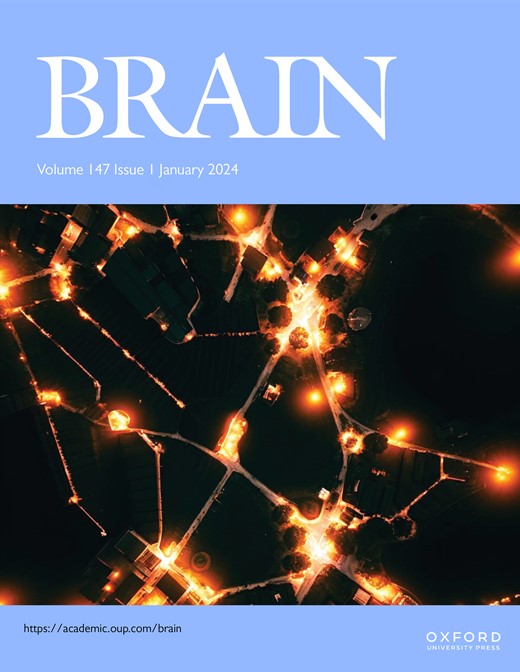皮层tau沉积促进阿尔茨海默病中连接白质区域的萎缩。
IF 11.7
1区 医学
Q1 CLINICAL NEUROLOGY
引用次数: 0
摘要
在阿尔茨海默病(AD)中,原纤维tau蛋白病理是神经变性和皮层萎缩的关键驱动因素。然而,新出现的证据表明,tau聚集物也会导致白质(WM)损伤。具体来说,生理性tau稳定轴突内微管,而过度磷酸化的tau破坏微管的完整性,导致神经元内tau聚集、神经元断开和轴突变性。因此,我们研究了皮质tau是否会促进AD相关WM区域的萎缩。为此,我们纳入了来自AD谱系的186名淀粉样蛋白阳性(Aβ+)患者和来自ADNI的102名认知正常(CN)淀粉样蛋白阴性(Aβ-)患者,并进行了基线淀粉样蛋白pet、tau-PET和t1加权MRI。纵向tau- pet和MRI(~ 2年)可用于138名参与者的子集,以进一步评估随着时间的推移tau积累与WM萎缩之间的关系。为了进行复制,我们纳入了来自A4/LEARN队列的378/60名CN a β+/ a β-参与者,并进行了基线淀粉样蛋白pet、tau-PET和t1加权MRI,其中144 /4 CN a β+/ a β-受试者进行了约5年的纵向tau-PET和MRI。从脑组图谱的210个皮质区域提取皮质tau-PET标准化摄取值比。此外,我们使用基于弥散MRI的纤维束成像模板,使用分段t1加权MRI确定连接皮质区域的纤维束的WM体积。使用线性回归,我们测试了基线时较高的皮质tau-PET是否与(i)较低的基线WM体积和(ii)随着时间的推移,更快的WM体积损失有关,以及(iii)是否更快的纵向tau-PET增加与更快的WM损失有关。对反向模型的测试检验了基线WM萎缩是否预示着随后连接区域的tau-PET增加更快。模型根据年龄、性别、颅内容积、WM高强度容积、ApoE4状态和整体淀粉样蛋白pet进行调整。在ADNI中,颞区皮质tau-PET基线升高与相邻区域基线WM体积降低相关,在整个AD谱患者中效果更明显,而在临床前A4/LEARN样本中相关性较弱。在这两个样本中,较高的基线颞顶叶tau-PET以及随着时间的推移,更快的tau-PET增加与连接的WM区域的体积损失加速显著相关,这在AD谱系的个体中尤为明显。重要的是,基线WM体积并不能预测相邻皮质区域随后的tau- pet变化率,这表明纤原tau蛋白与随后的WM变性之间存在单向关系。总之,我们的研究结果表明,皮层tau积聚促进AD患者邻近WM区域的萎缩,强调tau诱导的轴突变性和潜在的神经元断开可能在疾病进展中起关键作用。本文章由计算机程序翻译,如有差异,请以英文原文为准。
Cortical tau deposition promotes atrophy in connected white matter regions in Alzheimer's disease.
In Alzheimer's disease (AD), fibrillar tau pathology is a key driver of neurodegeneration and cortical atrophy. Yet, emerging evidence suggests that tau aggregates also contribute to white matter (WM) damage. Specifically, physiological tau stabilizes intra-axonal microtubules, while hyperphosphorylated tau disrupts microtubule integrity, ensuing intraneuronal tau aggregation, neuronal disconnection, and axonal degeneration. Therefore, we investigated whether cortical tau promotes atrophy in connected WM regions in AD. To this end, we included 186 amyloid-positive (Aβ+) patients across the AD spectrum and 102 cognitively normal (CN) amyloid-negative (Aβ-) participants from ADNI, with baseline amyloid-PET, tau-PET, and T1-weighted MRI. Longitudinal tau-PET and MRI (∼2-years) were available for a subset of 138 participants, to further assess the relationship between tau accumulation and WM atrophy over time. For replication, we included 378/60 CN Aβ+/Aβ- participants from the A4/LEARN cohort with baseline amyloid-PET, tau-PET, and T1-weighted MRI, where a subset of 141/4 CN Aβ+/Aβ- subjects had ∼5-year longitudinal tau-PET and MRI. Cortical tau-PET Standardized Uptake Value Ratios were extracted from 210 cortical regions of the Brainnetome Atlas. In addition, we used a diffusion MRI-based tractography template to determine WM volumes of fiber tracts connected to cortical regions using segmented T1-weighted MRI. Using linear regression, we tested whether higher cortical tau-PET at baseline was associated with (i) lower baseline WM volume and (ii) faster WM volume loss over time, and (iii) whether faster longitudinal tau-PET increases paralleled faster WM loss. Testing the reverse model examined whether baseline WM atrophy predicted faster subsequent tau-PET increase in connected regions. Models were adjusted for age, sex, intracranial volume, WM hyperintensity volume, ApoE4 status and global amyloid-PET. In ADNI, elevated baseline cortical tau-PET in temporal regions was associated with lower baseline WM volume in adjacent regions, with more pronounced effects in patients across the AD spectrum and with weaker associations in the preclinical A4/LEARN sample. In both samples, higher baseline temporo-parietal tau-PET as well as faster tau-PET increase over time were significantly linked to accelerated volume loss in connected WM regions, which was especially pronounced in individuals on the AD spectrum. Importantly, baseline WM volume did not predict subsequent tau-PET change rates in adjacent cortical regions, suggesting a unidirectional relationship between fibrillar tau and subsequent WM degeneration. Together, our findings suggest that cortical tau accumulation promotes atrophy in adjacent WM regions in AD, highlighting that tau-induced axonal degeneration and potentially neuronal disconnection may play a pivotal role in disease progression.
求助全文
通过发布文献求助,成功后即可免费获取论文全文。
去求助
来源期刊

Brain
医学-临床神经学
CiteScore
20.30
自引率
4.10%
发文量
458
审稿时长
3-6 weeks
期刊介绍:
Brain, a journal focused on clinical neurology and translational neuroscience, has been publishing landmark papers since 1878. The journal aims to expand its scope by including studies that shed light on disease mechanisms and conducting innovative clinical trials for brain disorders. With a wide range of topics covered, the Editorial Board represents the international readership and diverse coverage of the journal. Accepted articles are promptly posted online, typically within a few weeks of acceptance. As of 2022, Brain holds an impressive impact factor of 14.5, according to the Journal Citation Reports.
 求助内容:
求助内容: 应助结果提醒方式:
应助结果提醒方式:


